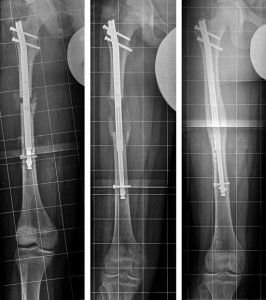
X-rays show femur with nail inserted before length- ening (left), after lengthening (center), and after the lengthened bone has healed (right). (Images courtesy of John Herzenberg, MD, FRSCS.)
Intramedullary nail is ‘a step forward’
By Samantha Rosenblum
Preliminary evidence supports the use of a new internal technique for limb lengthening, according to data from the International Center for Limb Lengthening (ICLL) at the Rubin Institute for Advanced Orthopedics of Sinai Hospital in Baltimore.
The ICLL has used an internal lengthening nail in 82 patients, 48 of whom were younger than 18 years, in the past two years and reports that patients experience less pain, less joint stiffness, and fewer general complications compared with lengthening using external fixation.
The nail, an extendible intramedullary rod for lengthening the femur and tibia, utilizes a magnetic-powered external remote controller that lengthens it noninvasively. Use of the nail addresses many problems associated with external fixation, such as pin-site infections, muscle tethering, and pain, according to the ICLL.
In a paper presented at the American Academy of Orthopaedic Surgeons 2014 meeting in New Orleans, researchers at the ICLL asked 15 patients (or parents of young patients, if appropriate) who had undergone limb lengthening with both external and internal techniques to compare the experiences. The average age at external fixation was 9 years; for internal lengthening, 14 years.
On a 10-point scale, patients on average ranked visual analog pain associated with external fixation at a 7, while the average pain associated with internal fixation was a 3. Use of pain medication averaged 11 weeks with external fixation and five weeks for internal fixation; time to full weight bearing averaged 21 weeks for both techniques. The internal device was associated with higher levels of patient satisfaction regarding ease of physical therapy, cosmetic results, complication rate, day-to-day function, and return to activity. Earlier results from the same study were presented in July 2013 at the annual meeting of the Limb Lengthening and Reconstruction Society.
Joshua Hyman, MD, associate professor of orthopedic surgery at Columbia University College of Physicians and Surgeons in New York City and director of the pediatric orthopedic fellowship at Morgan Stanley Children’s Hospital of New York, has yet to use the nail but noted that external fixation is associated with a number of potential risks.
“I always have a discussion with patients and their parents about the risk of superficial infection, which I describe as about one hundred percent,” Hyman said. Other risks include injury to nerves and blood vessels at pin sites or when the bone is cut.
The benefits of internal lengthening are not limited to physical advantages, according to John Herzenberg, MD, FRSCS, director of Pediatric Orthopedics at Sinai Hospital and of the ICLL, who presented the study findings.
“It’s certainly psychologically better for the patient because they don’t have a huge external scaffolding contraption outside their leg attached to them for months at a time,” Herzenberg said. “If someone has [internal lengthening], you wouldn’t know if they were sitting next to you. It takes the whole process and makes it more comfortable.”
Smaller versions of the original nail are becoming available, which will increase its potential for use in young children. The latest generation of the internal system is also four times stronger than the original, Herzenberg said.
Hyman says he sees a future for internal lengthening.
“It gives us another tool for treating deformity. And, when we speak about deformity, most of us think about a wavy or a curvy bone. But it also means a short bone, and it gives us another way to address this,” he said.
There have been about 700 nails implanted worldwide. But the new technique has not solved all the problems associated with limb lengthening, Herzenberg said.
“We’re still stretching muscles, we’re still stretching bone, and the bone still has to heal,” he said. “It’s a step forward, but not a panacea. It doesn’t cure all the problems of making limb lengthening a simple process. It’s still a very serious procedure.”
The new nail is also a straight nail, which limits its ability to lengthen crooked bones.
“If this is the case, you could use an external fixator with hinges that allows straightening of the fixator as well as lengthening,” Herzenberg said. Another alternative might be to perform an osteotomy to straighten the bone and then use the nail once the bone has healed.
Samantha Rosenblum is a journalism student at Northwestern University in Evanston, IL.
Sources:
Herzenberg JE, Standard SC, Landge V, Specht SC. Comparison of internal and external fixation for limb lengthening patients who have experienced both. Presented at the American Academy of Orthopaedic Surgeons 2014 Annual Meeting, New Orleans, March 2014.
Herzenberg J, Standard S, Conway J, et al. Satisfaction of patients who have undergone lengthening with both internal and external fixation: A comparison study. Presented at the 23rd Annual Scientific Meeting of the Limb Lengthening and Reconstruction Society, New York, July 2013.









